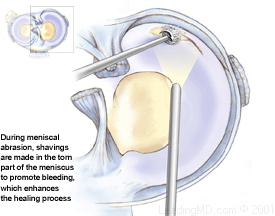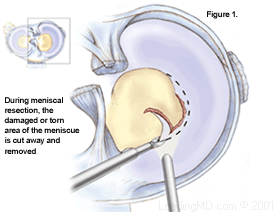






 How
is a meniscus injury treated?
How
is a meniscus injury treated?
When determining the treatment for a meniscal tear, the orthopaedic surgeon
will consider the following factors:
After
considering these factors the doctor will choose to treat the injury
non-operatively or surgically.
Non-operative Treatment
Many small meniscal tears will heal without surgical treatment. Also,
some tears may have no symptoms and in other tears, symptoms may eventually
disappear. Partial tears, degenerative tears, and stable tears
may be observed for 2 - 3 months. If symptoms disappear, no
surgery is needed. The use of a knee brace and restriction
of activities may be recommended to prevent further injury.
Surgical Treatment
Surgical treatment for a meniscal tear may be indicated if:
 If
surgery is recommended, the procedure chosen is usually dependent
on the location and type of meniscal tear. All procedures are performed
through an arthroscope and usually don't require an overnight hospital
stay.
If
surgery is recommended, the procedure chosen is usually dependent
on the location and type of meniscal tear. All procedures are performed
through an arthroscope and usually don't require an overnight hospital
stay.
Trephination/
Abrasion Technique
 This
procedure is used for stable tears located on the periphery
near the meniscus and joint capsule junction, where there's a
good blood supply. Multiple holes or shavings are made
in the torn part of the meniscus to promote bleeding, which enhances
the healing process.
This
procedure is used for stable tears located on the periphery
near the meniscus and joint capsule junction, where there's a
good blood supply. Multiple holes or shavings are made
in the torn part of the meniscus to promote bleeding, which enhances
the healing process.
Partial Resection
This surgical procedure is used for tears located in the inner
2/3 of the meniscus where there is no blood supply.
The goal is to stabilize the rim of the meniscus by removing as little
of the inner meniscus as possible. Only the torn part of the meniscus
is removed. If the meniscus remains mostly intact with only the inner
portion removed, the patient usually does well and does not develop
early arthritis.
Complete Resection
 This
procedure involves the complete removal of the damaged
meniscus. This technique is only performed if absolutely necessary.
Removal of the entire meniscus frequently leads to the development
of arthritis.
This
procedure involves the complete removal of the damaged
meniscus. This technique is only performed if absolutely necessary.
Removal of the entire meniscus frequently leads to the development
of arthritis.
Meniscal Repair
Repairs are performed on tears near the outer 1/3 of the meniscus where
a good blood supply exists, or on large tears that would require
a near-total resection. The torn portion of the meniscus is repaired
by using either sutures or absorbable
fixation devices. These devices include arrows, barbs, staples,
or tacks that join the torn edges of the meniscus so they can heal.
Meniscal Replacement
Experimental attempts to replace damaged meniscus are seen as important
recent advances in orthopaedic medicine. The new technology mentioned
here has been performed at a few surgical centers across the country
on a small number of patients.
![]()
![]()